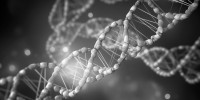
Link between Cancer and Aging
Age and cancer risk are intertwined, but why? Researchers at Yale University delved into the world of epigenetics to uncover the link between aging, cell replication, and cancer susceptibility. Their groundbreaking study reveals a "replication fingerprint" in DNA methylation data that could hold the key to understanding individual differences in cancer risk. Join us as we unveil the secrets of aging and cancer through the lens of epigenetic changes.
"More than Bad Luck": Unveiling the Link between Cancer and Aging through Epigenetic Changes
Aging is a significant risk factor for cancer, with the risk increasing considerably between the ages of 25 and 65. While some cancers are unrelated to age, it remains a prominent factor in the disease. The "bad luck hypothesis" proposed in 2015 suggested that random mutations during cell divisions play a major role in cancer development, overshadowing genetic predisposition and environmental factors.
However, recent studies have indicated that individual differences in cancer risk within specific tissues may not be fully explained by population-level statistics. Epigenetic changes, particularly DNA methylation (DNAm), have been found to be significantly altered during cell proliferation and aging. Understanding the interplay between aging, cell replication, and epigenetic alterations may provide valuable insights into the differential risk of cancer among individuals.
Exploring Replication-Driven Changes and Cancer Susceptibility
In a recent study published in Science Advances, researchers at Yale University investigated the relationship between age-related epigenetic changes, replication-driven changes, and cancer risk. The researchers aimed to identify a "replication fingerprint" in DNAm data that could be associated with aging, tumorigenesis, and cancer risk.
 To test these hypotheses, we quantified a “replication fingerprint” in DNAm data derived from extensively passaged immortalized human cells using a de novo computational training platform, contrary to the common top-down training methods, which are considered a “black box.”
To test these hypotheses, we quantified a “replication fingerprint” in DNAm data derived from extensively passaged immortalized human cells using a de novo computational training platform, contrary to the common top-down training methods, which are considered a “black box.”
Identifying the Replication Fingerprint in DNAm Data
To identify the replication fingerprint, the researchers used extensively passaged immortalized human cells and applied a de novo computational training platform. They discovered two modules, named "yellow" and "tan," showing consistent increases in DNA methylation changes with both cell proliferation in vitro and aging in vivo across various tissues. These modules were enriched in regions associated with polycomb repressive complex 2 (PRC2) and pluripotency factors, suggesting their implication in cancer development.
Unveiling the CellDRIFT Composite Measure: A Clue to Cancer Risk
The researchers created a composite measure called CellDRIFT based on CpGs in the yellow and tan modules. They tested CellDRIFT in various cancers and found that it was higher in tumors compared to normal tissues and in normal tissues from individuals who later developed cancer compared to healthy controls. Moreover, CellDRIFT positively correlated with tissue-specific cancer risk and lifetime stem cell divisions.
 To directly test the associations between these signals and changes in aging and cancer, we created a composite measure from the 2322 CpGs in the yellow and tan modules, termed CellDRIFT (Cellular Division and Replication Induced FingerprinT) (Fig. 2D and fig. S7).
To directly test the associations between these signals and changes in aging and cancer, we created a composite measure from the 2322 CpGs in the yellow and tan modules, termed CellDRIFT (Cellular Division and Replication Induced FingerprinT) (Fig. 2D and fig. S7).
Cellular Reprogramming's Impact on Epigenetic Changes
The researchers explored the effect of cellular reprogramming on CellDRIFT and found that during the maturation phase of reprogramming, there was a significant decrease in CellDRIFT, suggesting a potential reversal of epigenetic changes. However, upon long-term passaging of pluripotent stem cells, CellDRIFT increased again, indicating that replication-related epigenetic drift may persist even in pluripotent cells.
Understanding Aging, Cell Replication, and Cancer Risk
This study highlights the significance of epigenetic changes driven by cell replication in aging and cancer risk. Understanding these mechanisms may offer insights into cancer development and potential interventions to slow or reverse epigenetic changes associated with aging and cancer. The CellDRIFT composite measure may prove useful in cancer prognosis and personalized risk assessment, although further research is needed to validate its potential clinical applications.
Epigenetic Insights into the Aging-Cancer Link
Aging and cancer are intrinsically linked, and the study by Minteer et al. sheds light on the role of replication-driven epigenetic changes in this association. While the "bad luck hypothesis" emphasizes the role of random mutations in cancer development, the study underlines the importance of epigenetic alterations, particularly in DNA methylation. Advancements in understanding the interplay between aging, cell replication, and epigenetic changes may pave the way for new strategies in cancer prevention and treatment, ultimately improving individual health outcomes.